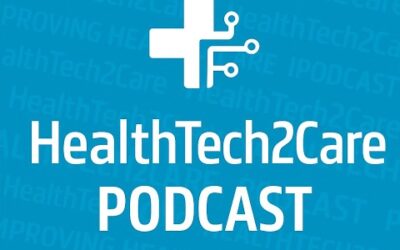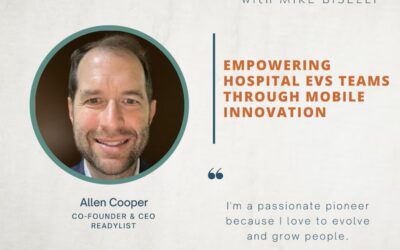Empowered Patient: Digital Tools For Environmental Service Leaders and Staff
Check out the latest podcast appearance by our CEO Allen Cooper!
Listen in to hear Allen engage in conversations about the current state of EVS care. The discussion focuses on the challenges faced by environmental services (EVS) leaders in hospitals and how ReadyList’s digital solutions help improve hospital cleanliness, efficiency, and patient safety.
Expect to learn about those key challenges, the current digital solutions out there for leaders with ReadyList, the difference that digital to traditional methods has in the EVS space, key data metrics that Readylist helps capture, the impact this all has on staff, and more!
“When you look at it from a patient’s perspective, I think meeting and exceeding patients’ expectations of getting great quality care is probably at the forefront of everyone’s mind. There’s a lot of competition out there between hospitals and health systems. I think, looking from a patient’s point of view, making sure that the patients are delighted is number one. A close number 2, if not number 1, is making sure that the hospitals themselves are controlling and reducing their healthcare-associated infections. I think that’s been such a hot topic in the last 10-plus years, making sure that the patients are safe and taken care of, and when they leave, they’re in a better spot than before they came.”
I’m thinking this also affects how nurses feel about the environment and physicians, other clinicians in the workflow there. And would you say that that is a factor of when someone decides just need to find a new facility to work at because it’s a safer facility?:
Allen:
A hundred percent. You raised two really good points there. One is when you’re thinking about it from the pure, I’m a physician treating a patient, whether it’s surgery or whatever the case may be, their brand in my opinion, aligns with that hospital. Even if they’re not employed by the hospital, they’re still affiliated and if the facility itself can’t align with the quality of your procedure. I could see the doctors and physicians finding a different facility to associate themselves with, so that’s definitely something to consider. The nursing part of it is also interesting because they also treat and manage the patients as well with the same lens. And then furthermore, whatever isn’t being done by the EVS team notoriously, it’s the nurse that has to do it. And so there’s that dissatisfaction of instead of managing and treating the patients, which is their number one goal, they end up doing, whether it’s tidying up a room doing some of the basics of just missing pillows or it’s missing these two equipments and the nurses are typically still obligated to do some of that extra work because they’re going to be reflected by the patient.
Usually the patient looks at the nurse first and if the room itself is not equipped to actually have a patient in it and there’s things that are missed, the patient doesn’t always understand that it’s not the nurse that was not doing their job, it was someone else, but the nurse is the one that it’s going to look poorly on. So yeah, that’s very much an impact. And at the end of the day, they may find a different role somewhere else where they feel like the hospital itself is really taking care of their patients, which inherently is taking care of them as well.
So when you bring your solution into a hospital, what kind of metrics do you use to show that you are really improving operational efficiency and patient care?
Allen:
Yeah, great question. We have four key metrics we maximize. One is cleaning progress and we call that more of the compliance. And that’s just ensuring that all the rooms that are needed to be cleaned either daily and sometimes they’re supposed to be cleaned two or three times a day depending on the units that it actually is being done, and this particular metric ensures that if they are being audited that they actually are meeting the standards of any room that’s required to be clean, they can actually demonstrate and show that they’re actually doing it. So the compliance of rooms that are supposed to be turned over and cleaned daily or at least multi are being done. Productivity is another one for us where our goal is to make sure that they maximize the time of the staff and having a sense of understanding of how many cleans on average does an employee actually conduct in a given shift….



